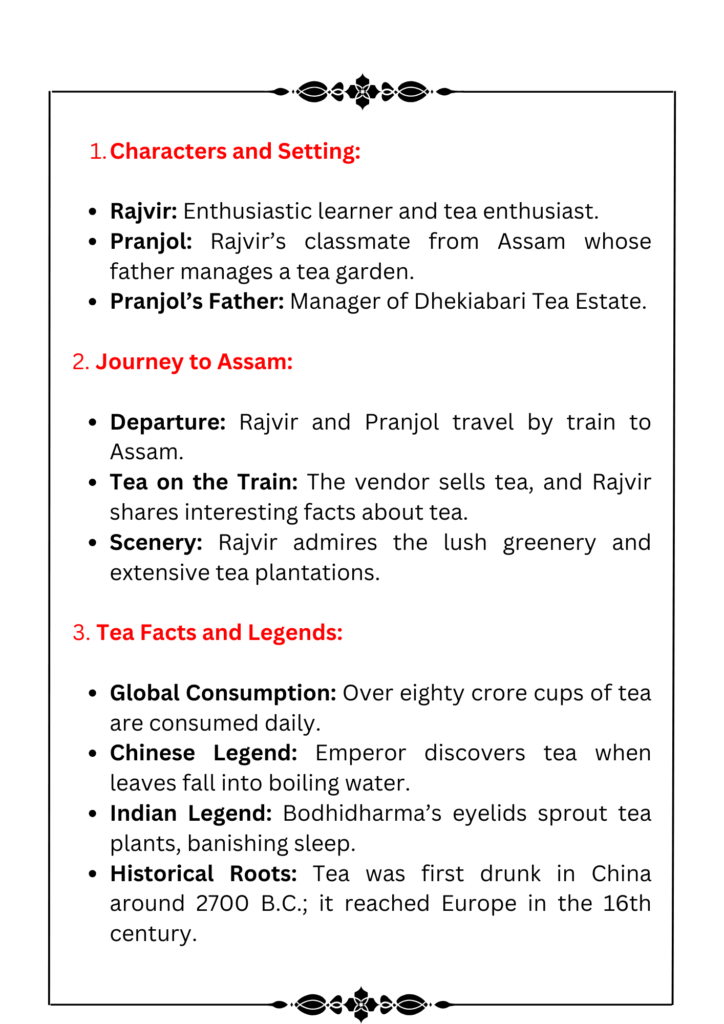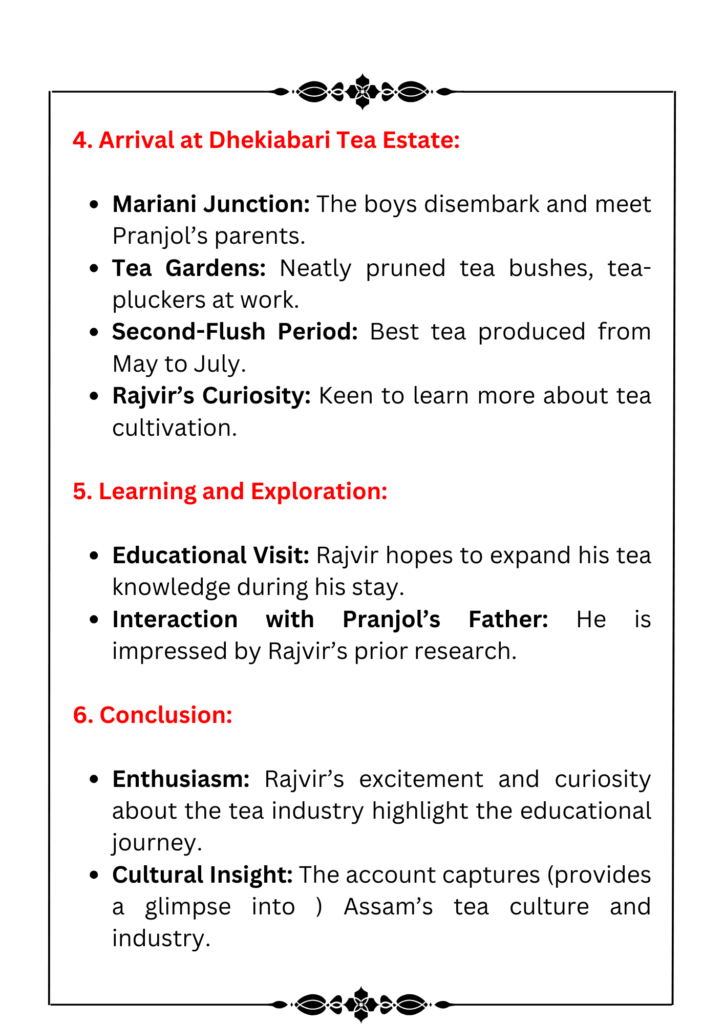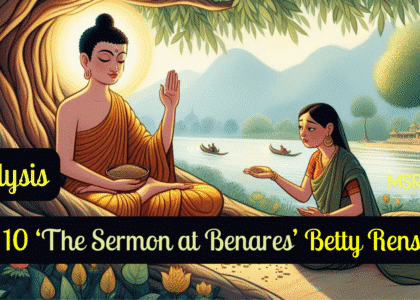Chapter 5- Glimpses of India (Part 3) ‘Tea from Assam’ Summary, Key Points, Textbook Questions Answers with Extra Questions.
Chapter 5- Glimpses of India (Part 3) ‘Tea from Assam’ by Arup Kumar Datta
Table of Contents
More from Chapter 5: Part 1 ‘Baker from Goa‘, Part 2 ‘Coorg‘
Summary “Tea from Assam”:
In Part 3 of ‘Glimpses of India’ titled ‘Tea from Assam, ’ by Arup Kumar Datta, Rajvir and Pranjol, schoolmates from Delhi, travel to Pranjol’s home in Assam, where Pranjol’s father manages a tea plantation. Rajvir shares fascinating facts about tea on the train, including its origins and legends. As they arrive in Assam, Rajvir is amazed by the lush green tea gardens.
Pranjol explains that Assam has the world’s largest concentration of tea plantations. At the Dhekiabari Tea Estate, Rajvir sees tea pluckers at work and learns about the second-flush period, which produces the best tea. Rajvir’s curiosity is piqued, and he is eager to learn more during his stay at the tea garden.
Key Points from (Part 3) “Tea from Assam” by Arup Kumar Datta:
Explanation of Part 3c’Tea of Assam- Glimpses of India’ for Auditory Learners:
Duration: 8 minutes
Exam-oriented. Concise. Comprehensive. Note-Format
Question Answers “Tea from Assam”:
Thinking About Language:
I. 1. Look at these words: upkeep, downpour, undergo, dropout, walk-in. They are built up from a verb (keep, pour, go, drop, walk) and an adverb or a particle (up, down, under, out, in).
i) A heavy downpour has been forecast due to low pressure in the Bay of Bengal.
(ii) Rakesh will undergo major surgery tomorrow morning.
(iii) My brother is responsible for the upkeep of our family property.
(iv) The dropout rate for this accountancy course is very high.
(v) She went to the Enterprise Company to attend a walk-in interview.
2. Now fill in the blanks in the sentences given below by combining the verb given in brackets with one of the words from the box as appropriate.
over, by, through, out, up, down
(i) The Army attempted unsuccessfully to overthrow the Government. (throw)
(ii) Scientists are on the brink of a major breakthrough in cancer research. (break)
(iii) The State Government plans to build a bypass for Bhubaneswar to speed up traffic on the main highway. (pass)
(iv) Gautama’s outlook on life changed when he realised that the world is full of sorrow. (look)
(v) Rakesh seemed unusually downcast after the game. (cast)
II. Notice how these -ing and -ed adjectives are used.
1. Think of suitable -ing or -ed adjectives to A the following Qs. You may also use words from those given above.
How would you describe
(i) A good detective serial on television is intriguing/fascinating/captivating.
(ii) A debate on my/your favourite topic ‘Homework Should Be Banned’ is engaging/stimulating/thought-provoking.
(iii) When I/you stay indoors due to incessant rain, I/you feel bored/restless/frustrated.
(iv) When I/you open a present, I/you feel excited/delighted/thrilled.
(v) When I/you watch my/your favourite programme on television, you feel entertained/engrossed/amused.
(vi) The look on my/your mother’s face as I/you waited in a queue, was exasperated/frustrated/annoyed.
(vii) When tracking a tiger in a tiger reserve forest, I/you feel thrilled/exhilarated/excited.
(viii) The story I/you have recently read or a film I/you have seen is fascinating/gripping/compelling.
2. Now use the adjectives in the exercise above, as appropriate, to write a paragraph about Coorg.
Sample Paragraph:
| Coorg is a captivating destination in Karnataka, India, known for its enchanting coffee plantations and lush greenery. The area offers a perfect blend of natural beauty and cultural richness. The locals are friendly and always eager to share their stories and traditions. As I strolled through the plantations, I was thrilled by the stunning scenery and the fresh, invigorating air. The food was delightful, adding to my excitement with every meal. Coorg’s rich history was fascinating, filled with tales of bravery and courage. Even though the long queues at famous tourist spots were frustrating at times, the entire experience was so engaging that I hardly noticed. Visiting Coorg was an unforgettable and enjoyable adventure. |
Speaking and Writing:
1. Read the following passage about tea.
India and tea are so intertwined together that life without the brew is unimaginable — a fact the Japanese and the Chinese knew anyway from ancient times, attributing to it numerous medicinal properties.
[Source: ‘History: Tea Anytime’ by Ranjit Biswas from Literary Review, The Hindu, 1 October 2006]
Collect information about tea, e.g. its evolution as a drink, its beneficial qualities. Then form groups of five and play the following roles: Imagine a meeting of a tea planter, a sales agent, a tea lover (consumer), a physician and a tea-shop owner. Each person in the group has to put forward his/her views about tea. You may use the following words and phrases.
• I feel …
• It is important to know …
• I disagree with you …
• I think that tea …
• I would like you to know …
• I agree with …
• It is my feeling …
• I suggest …
• May I know why you …
• I am afraid…
Sample:
| Tea Planter: I feel tea is an essential part of our culture now. It is important to know that tea plantations in Assam and Darjeeling have created jobs for many people. I suggest that we continue to support and grow this industry. Sales Agent: I think that tea is a great product to sell because it has wide varieties and flavours. I would like you to know that more people are buying tea now because they are learning about its health benefits. I agree with the tea planter that this industry is very important. Tea Lover (Consumer): I am a big fan of tea! I feel that tea is very relaxing and enjoyable. It is my feeling that tea is the best drink for any time of the day. I agree with the sales agent that tea has many wonderful flavours. Physician: I am afraid that some people drink too much tea, which can cause problems. However, tea has many beneficial qualities. It is important to know that tea can help with digestion and can have antioxidants. I think that tea can be good for health if consumed in moderation. Tea-Shop Owner: I feel that tea is a great way to bring people together. I suggest that everyone should try different kinds of tea. I agree with the tea lover that tea is relaxing and enjoyable. May I know why you think tea can harm health, physician? Physician: I disagree with you. While tea does have health benefits, consuming too much can lead to problems like insomnia or digestive issues. It’s important to drink tea in moderation to avoid these issues. |
2. You are a famous tea company’s sales executive and have been asked to draft an advertisement for the product. Draft the advertisement using the information you collected for the role play. You can draw pictures or add photographs and make your advertisement colourful.
Fun Excercise:

Extra Questions “Tea from Assam”:
Short Answer Type Questions:
Q1: What does Pranjol’s father do?
A1: Pranjol’s father manages a tea garden in Upper Assam. He oversees the tea plantation where tea bushes are grown, and tea leaves are harvested.
Q2: How does Rajvir react to the view of the tea garden?
A2: Rajvir is excited to see the tea garden. He is impressed by the vast fields of tea bushes and the beautiful scenery.
Q3: What exciting fact about tea does Rajvir share with Pranjol?
A3: Rajvir shares that over eighty crore (800 million) cups of tea are drunk daily worldwide. He also talks about tea’s origins and legends.
Q4: What is the second-flush period in tea cultivation?
A4: The second-flush period is when tea leaves are freshly sprouted. It lasts from May to July and produces the best quality tea.
Q5: Why is Pranjol less excited about the tea garden than Rajvir?
A5: Pranjol is not excited because he has grown up around tea gardens and is used to seeing them. For him, it is a common sight.
Q6: What does Rajvir plan to do during his visit?
A6: Rajvir plans to learn more about tea and tea cultivation during his visit. He wants to expand his knowledge beyond what he has read.
Q7: What are the people in the tea garden doing?
A7: The people in the tea garden are plucking newly sprouted tea leaves. They carry bamboo baskets and wear plastic aprons to collect the leaves.
Q8: How does Rajvir describe the scenery outside the train?
A8: Rajvir describes the scenery as green everywhere, with paddy fields giving way to tea bushes and a magnificent view of tea gardens and hills.
Q9: What did Rajvir know about tea before his visit?
A9: Before his visit, Rajvir knew that tea was very popular worldwide, and many cups were consumed daily. He also learned about its legends and history.
Q10: How did Pranjol’s father react to Rajvir’s knowledge about tea?
A10: Pranjol’s father was surprised by Rajvir’s knowledge about tea. He was impressed that Rajvir had done his homework before visiting.
Q11: What does Pranjol think about the tea gardens?
A11: Pranjol thinks tea gardens are widespread and less exciting. He has grown up with them and considers them a regular part of his life.
Q12: What kind of book is Pranjol reading on the train?
A12: Pranjol is reading a detective book on the train. He enjoys detective stories and often reads them during his travels.
Q13: What did Rajvir know about the history of tea?
A13: Rajvir knew that tea was first drunk in China around 2700 B.C. He also knew that the words for tea, ‘chai,’ and ‘chini’ come from Chinese.
Q14: What is the significance of the smoke in the distance?
A14: The smoke in the distance is coming from an ugly building that is part of the tea garden. It indicates where tea leaves are processed.
Q15: How did Rajvir and Pranjol travel to Dhekiabari?
A15: Rajvir and Pranjol drove to Dhekiabari. They drove off the main road and crossed a cattle bridge to reach the tea estate.
Long Answer Type Questions:
Q1: How does the author use descriptive language to show the setting and atmosphere of the tea garden in Assam?
A1: In “Tea from Assam,” the author describes the tea garden in detail to help readers imagine the scene. The lush green landscape is characterised by phrases like “a sea of tea bushes” and “densely wooded hills.”
The descriptions create a clear picture of the vast and beautiful tea fields. The author also contrasts the natural beauty of the tea bushes with the industrial building, which has smoke coming out of its chimneys.
By describing the tea pluckers, the gravel road, and the tractor, the author helps readers visualise the tea garden’s beauty and busy work.
Q2: What is the importance of the tea legends mentioned in the story, and what do they tell us about tea’s history and culture?
A2: The legends about tea in the story show its long history and cultural significance. The story of the Chinese emperor who accidentally discovered tea shows how tea became an essential part of Chinese culture.
The Indian legend about Bodhidharma, who grew tea plants from his eyelids, highlights tea’s unique place in Indian traditions. These stories help us understand that tea has been valued for a very long time in different cultures.
They show how tea started in China and later spread to other parts of the world, becoming important in many cultures.
Q3: How do Rajvir’s excitement about tea and Pranjol’s attitude towards it differ, and what does this tell us about them?
A3: Rajvir is very excited about tea. He is curious to learn about its history and how it has grown, which shows that he is eager and enthusiastic about new experiences.
On the other hand, Pranjol is less excited because he has grown up around tea gardens and is used to them. His attitude shows he is familiar with it but may need to be more relaxed by the tea culture.
The difference in their reactions shows how Rajvir’s fresh perspective and Pranjol’s everyday experience shape their feelings about tea.
Q4: Describe the scene Rajvir sees when he arrives at Dhekiabari Tea Estate. What details make the scene vivid and exciting?
A4: When Rajvir arrives at Dhekiabari Tea Estate, he sees a picturesque scene of neatly pruned tea bushes stretching across the land. The gravel road is lined with acres of these bushes.
The estate is bustling with activity as tea pluckers carry bamboo baskets on their backs, wear plastic aprons, and pick the newly sprouted tea leaves. A tractor passing by, carrying a trailer load of freshly picked tea leaves, further animates the scene.
The orderly rows of bushes and the hardworking pluckers make the scene both vivid and exciting, highlighting the beauty and scale of the tea plantation.
Q5: What does Rajvir know about tea before visiting Dhekiabari, and how does he plan to learn more about it during his visit?
A5: Before visiting Dhekiabari, Rajvir extensively researched tea. He knows exciting facts, such as tea’s legendary discovery by a Chinese emperor and Bodhidharma, and its history, including that tea was first drunk in China around 2700 B.C.
He also understands the tea harvesting periods, like the second flush, which yields the best tea. Rajvir plans to deepen his knowledge during his visit by observing the tea garden and learning from Pranjol’s father, Mr. Barua.
He hopes to gain practical insights and firsthand experience to enhance his understanding of tea production beyond what he has read.





